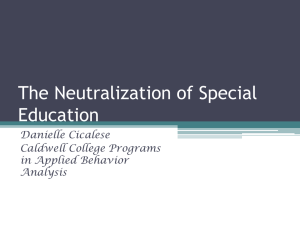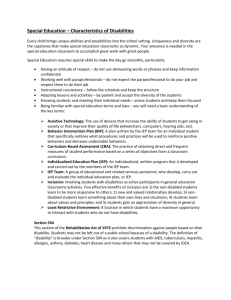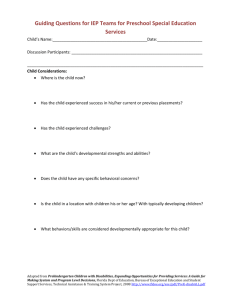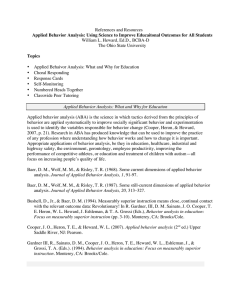What does the term "least restrictive environment" mean when
advertisement
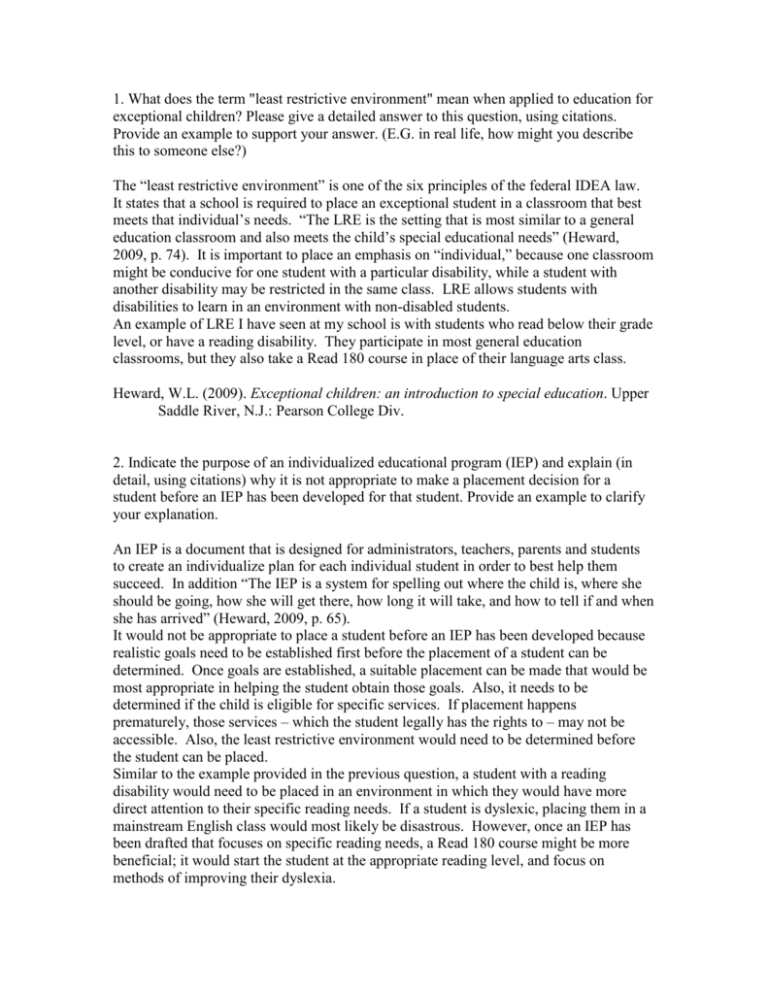
1. What does the term "least restrictive environment" mean when applied to education for exceptional children? Please give a detailed answer to this question, using citations. Provide an example to support your answer. (E.G. in real life, how might you describe this to someone else?) The “least restrictive environment” is one of the six principles of the federal IDEA law. It states that a school is required to place an exceptional student in a classroom that best meets that individual’s needs. “The LRE is the setting that is most similar to a general education classroom and also meets the child’s special educational needs” (Heward, 2009, p. 74). It is important to place an emphasis on “individual,” because one classroom might be conducive for one student with a particular disability, while a student with another disability may be restricted in the same class. LRE allows students with disabilities to learn in an environment with non-disabled students. An example of LRE I have seen at my school is with students who read below their grade level, or have a reading disability. They participate in most general education classrooms, but they also take a Read 180 course in place of their language arts class. Heward, W.L. (2009). Exceptional children: an introduction to special education. Upper Saddle River, N.J.: Pearson College Div. 2. Indicate the purpose of an individualized educational program (IEP) and explain (in detail, using citations) why it is not appropriate to make a placement decision for a student before an IEP has been developed for that student. Provide an example to clarify your explanation. An IEP is a document that is designed for administrators, teachers, parents and students to create an individualize plan for each individual student in order to best help them succeed. In addition “The IEP is a system for spelling out where the child is, where she should be going, how she will get there, how long it will take, and how to tell if and when she has arrived” (Heward, 2009, p. 65). It would not be appropriate to place a student before an IEP has been developed because realistic goals need to be established first before the placement of a student can be determined. Once goals are established, a suitable placement can be made that would be most appropriate in helping the student obtain those goals. Also, it needs to be determined if the child is eligible for specific services. If placement happens prematurely, those services – which the student legally has the rights to – may not be accessible. Also, the least restrictive environment would need to be determined before the student can be placed. Similar to the example provided in the previous question, a student with a reading disability would need to be placed in an environment in which they would have more direct attention to their specific reading needs. If a student is dyslexic, placing them in a mainstream English class would most likely be disastrous. However, once an IEP has been drafted that focuses on specific reading needs, a Read 180 course might be more beneficial; it would start the student at the appropriate reading level, and focus on methods of improving their dyslexia. Heward, W.L. (2009). Exceptional children: an introduction to special education. Upper Saddle River, N.J.: Pearson College Div. 3. Summarize three arguments against full-inclusion and then, for each argument; respond from the point of view of a full-inclusion advocate. One argument against full-inclusion is that it would place students in restrictive environments, ignoring the IDEA law. If students with specific disabilities were placed in general ed. classes, there is the possibility they would be placed in a class in which they could not be successful. An argument against this is that a teacher could modify instructional or differentiate his/her instructional so as to better suit the needs of the individual student. Another argument against full-inclusion is that special education students have individual needs and that “The very concept of ‘one best place’ contradicts this commitment to individualization” (Heward, 2009, p. 82). Someone who is for inclusion might argue that inclusion promotes equality and that we should “view full inclusion as a matter of social justice (e.g., Sapon-Shevin, 2007; Stainback, Stainback, & Ayres, 1996)” (Heward, 2009, p. 81). A third argument against full-inclusion is that teachers end up spending more time and energy on a few of the students that require the attention and in turn neglect the rest of the class. It is difficult to be a successful teacher when the ability level of the students has a wide range. A full-inclusion advocate might say that all students have the ability to learn and succeed regardless of a disability, so there should be no reason why they cannot be included. Also, it is not only cognitive skills we are building, but students with disabilities benefit from social skills and behavioral skills taught in a general ed. class. Heward, W.L. (2009). Exceptional children: an introduction to special education. Upper Saddle River, N.J.: Pearson College Div. 4. The definition for mental retardation/ID refers to both intelligence and adaptive behavior. What is the difference between intelligence and adaptive behavior. (Please describe these in detail and use citations). Give examples of tasks that are representative of each. Why is adaptive behavior included in the definition of mental retardation/ID? Intelligence can be defined as cognitive functioning or understanding. With mental retardation/ID, some deficits include “poor memory, slow learning rates, attention problems, difficulty generalizing what they have learned, and lack of motivation” (Heward, 2009, p. 139). Adaptive behavior is different from intelligence in that it is defined by the functional skills an individual has. While intelligence includes the ability to remember something and a lack of motivation, adaptive behavior includes daily living skills, social development and excessive and challenging behavior (Heward, 2009). A task that can be associated with intelligence would be memorizing the capitals of each state in the U.S. A student with mental retardation would have difficulty remembering each capital. A task that relates to adaptive behavior might be communication. It is difficult for an individual who has mental retardation to retain a close relationship with another because of the lack of understanding what appropriate social behavior is. One reason why adaptive behavior was included in the definition is because “present functioning must be considered within the context of community environments typical of the individual’s age peers and culture” (Heward, 2009, p. 133). Having the ability to drive or navigate public transportation in some cultures may be essential, while in others it is not a necessity. Another reason why it was included is because it is essential to know adaptive behaviors to determine “the supports a student requires for success in school, work, community, and home environments (Schalock, 1999; J.R. Thompson et al., 2004) (Heward, 2009, p. 138). By merely focusing on the cognitive disabilities of a student, it would be difficult to determine in which environment a student would be most successful. Heward, W.L. (2009). Exceptional children: an introduction to special education. Upper Saddle River, N.J.: Pearson College Div. 5. When you receive a student with a life-threatening allergy or other medical need, what should you be considering? Who are the people you must involve in this process? What do you need to know? (Please be detailed in your response). In most, if not all cases, a student should have an IHCP. This is included in an IEP if the student has one. The IHCP will let the teacher know about the history and diagnosis of the student, and it will also inform the teacher of preventive strategies and the proper procedures to follow provided the student has a reaction (Heward, 2009). Some people that should be involved in the process include the student, parents, teachers, administrators, counselors, nurse, lunchroom workers, aides, and if the student participates in sports, the coaches. A teacher should be provided with training in how to deal with a life threatening allergy. Another thing for the teacher to understand is how to prevent a reaction. The teacher should have phone numbers for the nurse, the student’s parents and the student’s doctor and they should be in an easily accessible place. Heward, W.L. (2009). Exceptional children: an introduction to special education. Upper Saddle River, N.J.: Pearson College Div. 6. Describe four ways that special and general education teachers can collaborate to serve students with ADHD. One way teachers can collaborate to serve students with ADHD is by modifying assignments. The teachers can decide what the expectations are, and find a way of reaching those goals, but in a way that is conducive to the student’s learning style. Another way teachers can collaborate is by reviewing the IEP. It is important for general education teachers to be reminded of what services a student qualifies for on their IEP. In addition, resources that would benefit the student will be listed in the IEP that the special education teacher has access to. A third way teachers can collaborate is to share curriculum. If a special education teacher has a lesson or an assignment the general education teacher will be implementing in the coming days, they can prep the student to help keep them on task. They can also adapt the lesson for the individual student so as to help the general education teacher. And a fourth way to collaborate is to determine the best way to assess the student. If they need a quiet area to take a test, the special education teacher might be able to monitor the student in their own class while the rest of the general education students complete the test in their normal classroom. This last essay question is more of an assignment for you to do. Please choose one of the websites that I have referenced in the first five modules. For this website, I would like you to do the following: a) Thoroughly read through and explore the website. b) Cite the website and copy the URL into your essay. c) Answer the following questions using complete sentences and providing a thorough response: 1. What is the main purpose of this website? (Describe the intended audience(s), etc.) 2. What kinds of information are available? 3. Review a resource on this website. Provide a two paragraph description of the resource and cite where you found it. In this paragraph please describe the applicability to its intended audience. 4. Who would you recommend this to? (IF) d) Finally, find the section in this website providing links to other resources (other websites, etc.) and go to at least two of them. Cite what you found and their purpose. This assignment should take you at least an hour to complete and should be at least 8 paragraphs long. Please use headings to separate your sections. Cite where appropriate. http://www.ncld.org/ 1. Main Purpose The main purpose of the National Center for Learning Disabilities is to educate. The NCLD was established to educate individuals with disabilities, parents, professionals and anyone who interacts with a person who has a disability. In addition, the organization supports and encourages the equality of those with disabilities in education and in the professional world, and they “promote[] research and programs to foster effective learning…” (NCLD). 2. Information Available This site provides an incredible amount of information on learning disabilities. It defines learning disability, provides basic facts like “Currently 2.5 million students are diagnosed with LD and receive special education services in our schools…” (NCLD). It also provides information about early warning signs and how to help someone with a disability live a successful life. Because LD impact so many areas of learning, the site explains how to improve reading, writing, spelling, oral skills and math. For reading, they cover a wide range of skills, from comprehension to expository reading. A literacy expert answered a variety of questions about programs and approaches to literacy that can be helpful for most grade levels. Social and emotional issues are another area covered by the site. They place an emphasis on this, citing the success of individuals with LD can be credited to their focus on setting goals, self-esteem and emotional stability among others. “Some of the characteristics that really make a difference in the lives of these individuals appear to fall within the socialemotional domain” (NCLD). For parents who have children struggling with a LD, the “In the Home” section would be beneficial. Learning disabilities don’t end at school, they are part of that individual’s life, and the disability will affect everyone in the home. The site provides information for how to go about living as normal a life as possible, for both the individual and the rest of the family. They discuss marriage and relationships, siblings, financial issues and even entertainment. And, the learning does not end at school. Home should be a place where the individual is able to learn valuable life skills, as well as continue to strengthen their academic skills. For instance, during the summer, continue to read to, or encourage the child to read as often as possible to keep their literacy skills sharp. Another valuable page on this site is “At School.” Parents can learn the rights their children have at school, and the support they should be receiving. There is also information about the parents’ rights, and what they have a say in. Teachers will also find helpful tips for teaching strategies and monitoring a student’s progress. One of the most difficult things for a child with a learning disability to face is that transition from high school to college or work. The site will help an individual prepare for a successful future by providing the steps needed to make that transition as smooth and easy as possible. There is also a section for current laws and policies in place and legislative updates on those policies. 3. Resource http://depts.washington.edu/chdd/ I searched through some sources on the NCLD site in hopes of finding one in Seattle and I found this resource listed. Located at the University of Washington, the Center on Human Development and Disability is a research center that focuses on genes and behavioral science. There is a research emphasis in 12 areas, including autism and dyslexia and dysgraphia. The research is cross-disciplinary bringing in specialists from a wide range of science disciplines. The resource is designed to share studies with other researchers, scientists and doctors. Or if a parent was researching autism, and they were interested in learning about ways of improving the life of a child with autism, or they were looking for someone to work with a child with autism, this site provides contact information for a number of reputable individuals. It also provides a number of links to autism projects. 4. Recommendation If I were to recommend this site it would probably be to someone who is conducting research on autism or dyslexia because those are the two areas I am most familiar with. Specifically, I would recommend it to someone who wanted to know more about how the brain is affected by these disabilities. I would also recommend this to people who work with children with autism. The links to autism projects such as clinical services are invaluable. Teachers could benefit from some of the trainings offered as well. 5. Resources (Websites) The “Get Ready to Read” site offers information about early literacy. There are screenings that parents can have their children participate in to determine their reading levels, activities like reading games to help improve literacy, and a number of other sources parents can reference about literacy. Another link offered by NCLD is the RTI Action Network, or the Response to Intervention. The goal of this site is to help parents prepare young children to be successful in life. It is a site focused on preventative measures, ensuring that children are being taught how to learn from an early age by developing a plan, setting goals and successfully implementing those plans. What is great about this site is that it is not only for parents and early intervention, but it provides resources and professional development for middle school and high school teachers. Resources: Center on Human Development and Disabilities. (2011). Retrieved May 2, 2011, from http://depts.washington.edu/chdd/ Get Ready to Read. (2011). Retrieved May 2, 2011, from http://www.getreadytoread.org/ National Center for Learning Disabilities. (2011). Retrieved May 2nd, 2011, from http://www.ncld.org/ Response to Intervention Action Network. (2011). Retrieved May 2, 2011, from http://www.rtinetwork.org/


